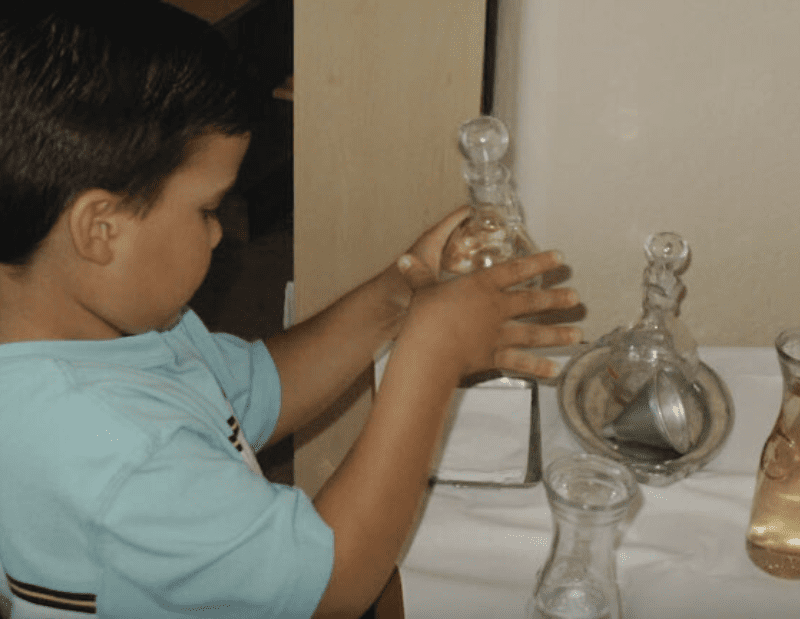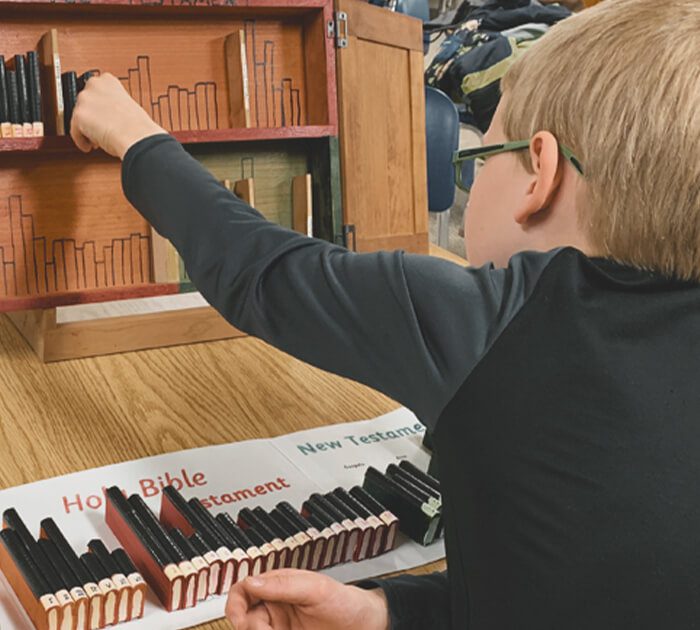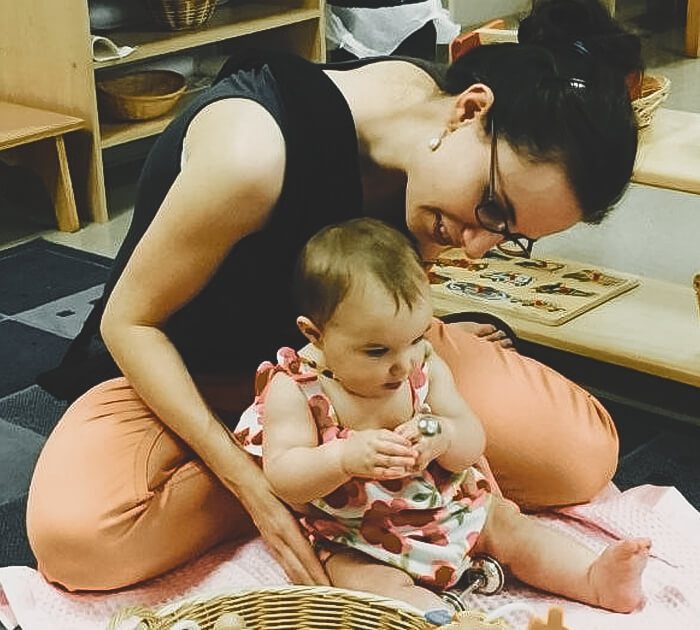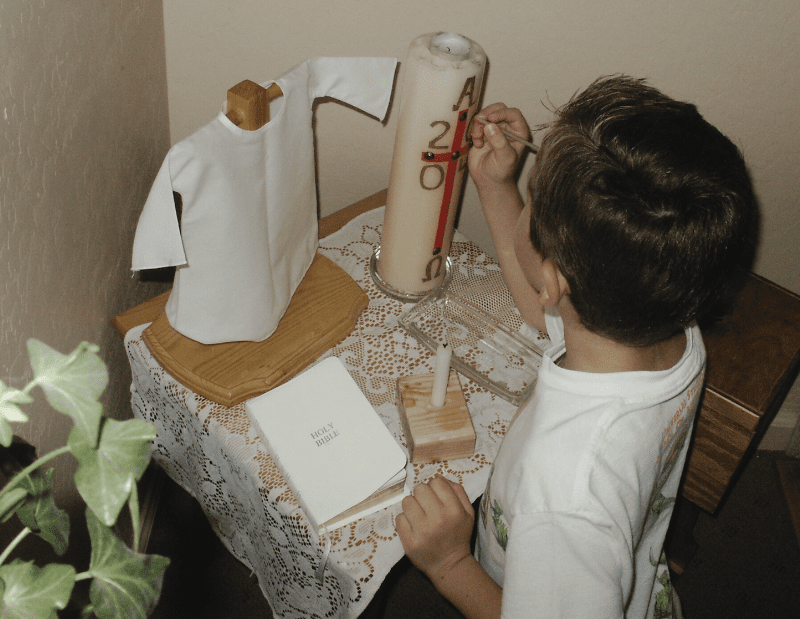Welcome
The CGS Approach

Join in the Wonder of the 3-6-Year-Old Child
The 3-6-year-old child is particularly capable of receiving and enjoying the most essential elements of our faith—the announcement of God’s love especially experienced through Jesus, the Good Shepherd, who died and is risen. Materials on the life of Jesus Christ and his teachings help to make the mystery of God concrete for the child. The heart of the catechesis for children under six revolves around the Parable of the Good Shepherd. Jesus announces that he is the Good Shepherd who calls each one by name. The sheep listen to the voice of the Shepherd and follow him.
The 3-6 year old child enters the mystery of the Eucharist by first learning the names of the articles used on the altar and then through the most important gestures including the preparation of the chalice, the epiclesis and offering, and the sign of peace. Through the experience of seeing these gestures, presented one by one, the Mass emerges as the Sacrament of the Gift. The child becomes acquainted with the historical character of the liturgy through the events of the Last Supper, Christ’s death, and His resurrection.

Celebrate the Growth of the 6-9 Year-Old Child
The elementary age child is captured by the image of the True Vine. “I am the vine, you are the branches, whoever remains in me, and I in him, will bear much fruit, because without me you can do nothing.” The proclamation responds to the deep need of these children to better know his or her relationship with God, family, friends, and the larger community. Moral parables offer a model for comparing their behavior with that of the Pharisee, the Tax Collector, or the Good Samaritan. The elementary children see the parts of the Mass—the Liturgy of the Word, the Preparation of the Gifts, the Eucharistic Prayer, and the Communion—as one unified prayer made of many smaller prayers. Children prepare for the celebration of First Communion (or Solemn Communion) through a series of communion meditations focusing on the relationship with Jesus. Preparation of personal missals filled with illustrations and prayers is also part of this preparation which helps to deepen their love and understanding of the Eucharist.

Honor the Independence of the 9-12 Year-Old Child
The history of salvation focusing on the plan of God as a plan of communion, a plan which links all people together through God’s love delight the older child. The emphasis is on our response to this unfolding generosity of God and recognition of the responsibilities that come with receiving God’s great gifts and seeing oneself as a collaborator with God. “What is the kingdom of God and my place in it?” is a cosmic query which lays the foundations for a life commitment in relationship with God. Materials on the Prophets of the Old Testament, the Gifts of God, the Miracles of Jesus, and expanded presentations on Liturgy and Scripture can also be found in the Level III Atrium.

Delight in the Discovery of the Infant and Toddler
Infant-Toddler Catechesis is an exploration of the very youngest child’s spirituality springing from the discovery of the child’s nature and religious potential revealed by the children to Maria Montessori, Sofia Cavalletti, Gianna Gobbi, Silvana Montanaro and those who continue to listen and observe the child in God’s light. When Rebekah Rojcewicz interviewed Sofia Cavalletti for her article in Essential Realities, she asked Sofia what was her greatest hope for Catechesis of the Good Shepherd. Sofia responded, “…that it would go younger and younger…” She said this out of a long process of observation of the children.
The Toddler Atrium is a prepared environment in which the youngest child’s spiritual life is fed by prayer, work and celebration aided by a catechist. Time is also given with the adults in the life of the child in this prepared environment for the infant or the young child to explore and the parent to grow in observation skills and interactions with his/her child aided by a catechist.

Our mission is to support catechists, parents, and others in the Church and beyond, as they grow in their understanding of the religious potential of children.
Relationships Bloom in Peaceful Spaces
An interpersonal relationship is always a mystery, all the more so when the relationship is between God and the child. We believe there is a deep bond between God and the child which produces in the child the desire to draw nearer to God. The adult, the catechist’s role is to prepare the environment, to offer selected presentations from scripture and liturgy. The catechist listens with the child and together they ask, “God, who are you? How do you love us?” The atrium (or prepared environment) is one of the important elements that helps the relationship between God and the child to flourish.
The Child
God and the child have a unique relationship with one another particularly before the age of six. The growth of this relationship should be assisted by the adult, but is directed by the Spirit of God within the child. Children need their own place to foster the growth of that relationship. This spiritual growth is best served through tangible but indirect means.
“If we want to help the child grow near to God, we should, with patience and courage…seek to go always closer to the vital nucleus of things. This requires study and prayer. The child himself will be our teacher if we know how to observe him.” – Sofia Cavalletti
The Atrium
The atrium (or prepared environment) is one of the important elements that helps the relationship between God and the child to flourish. After a theme has been presented, the child is free to choose an activity that will make possible the inner dialogue with the “Interior Teacher.” How does the atrium help to nourish this relationship? ~ The atrium can be compared to a retreat house facilitating recollection and silence. ~ The atrium is a place for religious life, for community and worship—not a classroom for instruction. ~ The atrium is a place of meaningful work through which the child can have a conversation with God.
The Adult
The catechist’s role is to prepare the environment and to give selected presentations from scripture and liturgy that “call forth” the child’s response rather than “pour in” information. The catechist listens with the child and together they ask, “God, who are you? How do you love us?” The adult reflects with the child on the questions generated by the presentations with the materials offered to the child to aid the child’s reflection. The catechists work together in a spirit of unity and harmony, in tune with God’s plan for communion in the history of salvation and in keeping with the themes of unity so strongly expressed in the parables of the Good Shepherd (John 10:1ff) and the True Vine. They generously offer their talents and experience for the good of all.
A Catechesis Born of Joy
A Catechesis Born of Joy
God and the Child with the Adult
God and the Child with the Adult
An interpersonal relationship is always a mystery, all the more so when that relationship is between God and the child. We believe there is a deep bond between God and the child which produces in the child the desire to draw nearer to God. The catechist’s role is to prepare the environment and to give selected presentations from scripture and liturgy that “call forth” the child’s response. The catechist listens with the child and together they ask, “God, who are you? How do you love us?” The adult reflects with the child on the questions generated by the presentations with the materials offered to the child to aid the child’s reflection. The atrium (or prepared environment) is one of the important elements that help the relationship between God and the child to flourish. After a theme has been presented, the child is free to choose an activity that will make possible the inner dialogue with the “Interior Teacher.”

